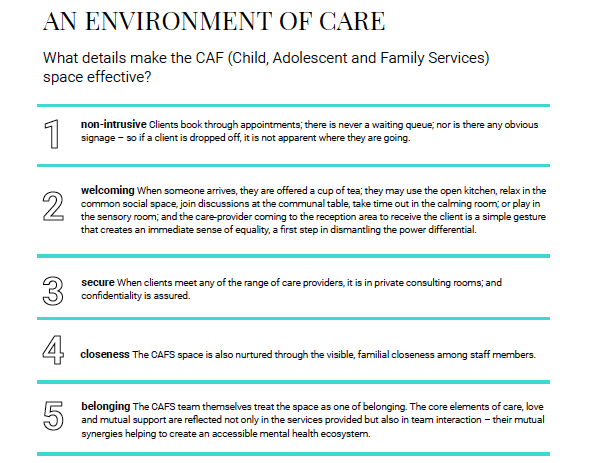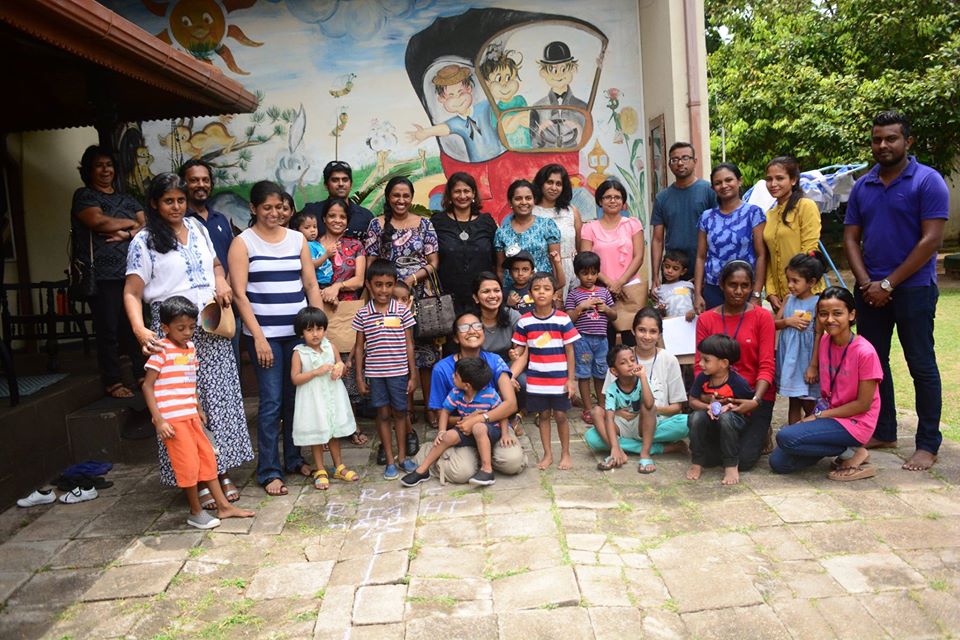A Home Away from Home
No, I’m not going in there!’ screamed a young child diagnosed with Asperger’s, who was scheduled for an appointment at a MH clinic where psychologist Giselle Dass was practicing at the time. The outburst was triggered by the board outside the clinic that read ‘Psychological Services’. This incident helped Giselle realize how simple details such as the text on a signboard hold the potential to make service users feel comfortable – or uncomfortable– in a space.
‘Was that a relative who just spotted me?’ ‘What will people say?’ The odour of disinfectants clogs the nostrils, there’s the stark white of claustrophobic corridors, paperwork, questions, and more questions… doubts might well crowd the mind of anyone who visits a hospital in Sri Lanka to seek MH support. When the team at Child, Adolescent and Family Services (CAFS), led by psychologists Giselle Dass and Suhaila Shafeek-Irshard, began to track the landscape of care in Sri Lanka, it realized that for children, adolescents, and their families,
MH care was available only at overstretched and under-resourced hospitals or private clinics. The services were primarily psychiatric, focused on prescribing psychotropic medication. While fear, shame, cost, and the pervasive stigma associated with MH issues were barriers for many people, the biomedical emphasis suggested that the social dimension of mental distress was being ignored.
Such an approach may prove particularly problematic when it comes to children and adolescents. 10-20% of adolescents experience MH challenges, and half of all mental disorders begin before the age of 14.(1) However, the clinical health system’s responses to adolescent needs in low-resource settings are often ineffective in dealing with these challenges holistically.(2) Getting adolescents to open up about their issues and seek help requires the use of creative methods, and an interdisciplinary approach that includes ways of supporting the families.
building a home
The CAFS team realized that children and adolescents needing psychosocial support did not respond well to typical clinical spaces in overburdened hospitals. What could a doctor do about the complex stressors embedded in their family life, their experience of schooling, or their uncertain futures? A shift was indicated – from the clinic to a space that felt more inclusive and secure – which led CAFS to develop a space based on the concept of “home”.
The CAFS-run “home” is a childand youth-friendly community hub where a range of multidisciplinary professionals provide psychosocial care to adolescents and children, and their families, across class and ethnicity. As deciding to reach out for support is a crucial step for any individual living with MH issues, it is important that their next set of interactions take place in a caring environment that helps sustain the decision to pursue treatment.
“Caring is about acknowledgement, concern, affirmation, assistance, responsibility, solidarity and all the emotional and practical aspects that enable life”

An Environment of Care
Spaces of care
The problem with MH service provision is not always one of supply, it may well be one of demand.(3) People living with MH issues don’t necessarily perceive the need for clinical services, or they are deterred by stigma, or by the power dynamic between clinician and patient. CAFS can be seen as a space of care, where high quality psychosocial services may be accessed beyond the clinical setting. “Caring is about acknowledgement, concern, affirmation, assistance, responsibility, solidarity and all the emotional and practical aspects that enable life” note Kleinman and van der Geest.(4)
Indeed, the CAFS home is a haven, a sanctuary, which allows an individual just to be. It is also a space that’s both welcoming, and private and secure, where intimate concerns can be discussed and worked through safely, facilitating a more effective treatment and management of MH issues.
This building of a space of care has required particular attention to the material culture of treatment. The team is constantly ‘tinkering’(5) with the space, literally and conceptually, inviting in certain service providers, adding small details to the interior, shaping interactions with clients and with each other. Unless one looks closely, one might miss this caring and careful labour.
For the team at CAFS, it is precisely through this crafted culture of care that their clinical work gains efficacy. Yet it raises a set of critical questions: How might we replicate this kind of caring space, if it is so dependent on the work of specific people within it? How might we measure or evaluate its impact? The CAFS team are working through such questions during their 12-month collaboration with UK-based support organization Ember. Their answers may well offer learnings that resonate across MH disciplines and contexts. ¤
Click here to download the full version of ReFrame III
References
